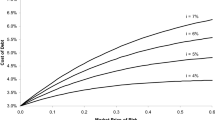Abstract
This article extends existing static analyses of debt-with-warrants' ability to signal by considering the intertemporal resolution of uncertainty. Provided that managers seek to minimize residual risk while correctly signalling prospects, callable bonds-with-warrants can prove strictly superior to analogous offerings of pure debt or of debt-with-equity. Because our intertemporal structure allows bonds to be called while warrants remain outstanding, these complicated offerings can also be successfully discriminated from convertible bonds. Managers can further accentuate dissipation of residual risk by simultaneously issuing debt-with-warrants and buying down existing equity (through share repurchase or cash dividends).
Similar content being viewed by others
References
Brennan, Michael J. and Alan Kraus, “Efficient Financing under Asymmetric Information.”Journal of Finance, 42, 5, 1225–1243, (December 1987).
Eckbo, B. Espen, “Valuation Effects of Corporate Debt Offerings.”Journal of Financial Economics, 15, 1/2, 119–151, (January/February 1986).
Emanuel, David C., “Warrant Valuation and Exercise Strategy.”Journal of Financial Economics, 12, 2, 211–235, (August 1983).
Fama, Eugene F., and Merton H. Miller,The Theory of Finance. Hinsdale, IL: Dryden Press 1972.
Green, Rchard C.,Investment and Financing Decisions under Moral Hazard. Unpublished Doctoral Dissertation, University of Wisconsin (1982).
Green, Richard C., “Investment Incentives, Debt, and Warrants.”Journal of Financial Economics, 13, 1, 115–136, (March 1984).
Harris, Milton, and Artur Raviv, “A Sequential Signalling Model of Convertible Debt Call Policy,”Journal of Finance, 40, 5, 1263–1281, (December 1985).
Ingersoll, Jr., Jonathan E., “A Contingent Claims Valuation of Convertible Securities’.Journal of Financial Economics, 4, 3, 289–321, (May 1977a).
Ingersoll, Jr., Jonathan E., ‘An Examination of Corporate Call Policies on Convertible Securities’.Journal of Finance, 32, 2, 463–478, (May 1977b).
Mikkelson, Wayne H., and M. Megan Partch, “Valuation Effects of Security Offerings and the Issuance Process.”Journal of Financial Economics, 15, 1/2, 31–60, (February 1986).
Myers, Stewart C., “Determinants of Corporate Borrowing.”Journal of Financial Economics, 5, 2, 147–175, (November 1977).
Robbins, Edward H., and John D. Schatzberg, “Callable Bonds: A Risk-Reducing Signalling Mechanism.”Journal of Finance, 41, 4, 935–949, (September 1986).
Robbins, Edward H., and John D. Schatzberg, “Callable Bonds: A Risk-Reducing Signalling Mechanism—A Reply.”Journal of Finance, 43, 4, 1067–1073, (September 1988).
Spence, A. Michael, “Competitive and Optimal Responses to Signals: An Analysis of Efficiency and Distribution.”Journal of Economic Theory, 7, 3, 296–332, (March 1974).
Stiglitz, Joseph E., “Some Aspects of the Pure Theory of Corporate Finance: Bankruptcies and Takeovers.”Bell Journal of Economics and Management Science, 3, 2, 458–582, (Autumn 1972).
Williams, Josesph, “Bonds, Stocks, and Options as Optimal Contracts Between Corporate Claimants.” Working paper No. 381, Salomon Brothers Center for the Study of Financial Institutions, Graduate School of Business Administtation, New York University (May 1986).
Author information
Authors and Affiliations
Additional information
The authors express our appreciation to Charlie Jacklin for discussions concerning this material. Our thanks also go to an anonymous referee atRQFA who helped us to refine our final product.
Much of the work for this paper was conducted while Professor Robbins was a Visiting Research Scholar at Stanford GSB.
Rights and permissions
About this article
Cite this article
Robbins, E.H., Schatzberg, J.D. Signalling under intertemporal resolution of uncertainty: Distinguishing debt-with-warrants from similar offerings. Rev Quant Finan Acc 4, 155–178 (1994). https://doi.org/10.1007/BF01074962
Issue Date:
DOI: https://doi.org/10.1007/BF01074962




